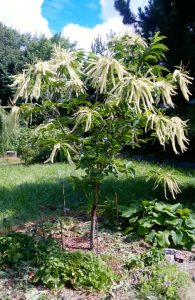Pollen in the Wind
mobile phone users-you have to scroll to the very bottom to see the right sidebar information
July 2, 2019
I am riding my bike around Wallingford, looking for a couple of big Chestnut (Castanea) trees. I know they are here somewhere. Our lonely Prococe tree needs pollen. I have her male catkins stuck on the end of my bike, in case there is another solo tree out there in need of pollen grains. (Chestnut trees receive pollen from the wind, but the second tree needs to be within a few hundred feet.)
Edible Chestnut trees (not related to Horse Chestnut) need pollen from a different variety in  order to pollinate properly. We have two varieties at the orchard … or should I say, had two trees. I am afraid the Maraval is in the bardo. She suffered childhood trauma and maybe that set the stage.
order to pollinate properly. We have two varieties at the orchard … or should I say, had two trees. I am afraid the Maraval is in the bardo. She suffered childhood trauma and maybe that set the stage.
When she was tiny, someone, something, broke the main branch. Without a proper grafting rubber strip, I used a rubber band and put her back together and it worked.
But then, more trauma as a teen. In her third season she was in great health and then, season four, there were bumps all up and down the trunk, and side branches were stubby. Bernie, from Washington Chestnut Company , said some name this ‘bubbly bark’. He suggested I cut the tree way back to just the lower part of the trunk. I did so and, once again, the tree recovered nicely.
Sat Jul 20, 10-12, Herb Class
Sun Jul 21, 2-4, Work Party
Sat Aug 3, 10-12, Work Party
At this time of year you can smell a Chestnut tree a block away. I can visualize that intersection. Was it 42nd? The house with the big trees is on a south west corner here somewhere.
Back to the poor Maraval. This spring, she was another casualty of winter moth larvae. They defoliated her whole south side. But, after they gorged and headed for the ground to start a new cycle, she showed some new leaf buds, just like the fruit trees did. Whew, I thought, she will be back. I walked away from her to attend more pressing matters.
But then, things went south. The leaves started to droop despite sufficient water. Then they turned brown. She hung on for dear life until, just recently, nothing green remained. (I hope to blog about her autopsy in the future.)
I spot the Wallingford trees. I snip four mature catkins, push two of them into a clean bag, and attach two others to the back of the bike to wave in the wind.
Back at the orchard, the Prococe Migoule is a picture of health. The styles of the female burs  have turned yellow and have spread out across the top of the flower; the tree is ready for pollen. I use the catkin like a paintbrush and lightly touch each female bur. If it’s a success, her burs will grow and have two or three nuts in them this fall.
have turned yellow and have spread out across the top of the flower; the tree is ready for pollen. I use the catkin like a paintbrush and lightly touch each female bur. If it’s a success, her burs will grow and have two or three nuts in them this fall.
The pollination period lasts two weeks so I am keeping the catkins on my bike. The more – chestnuts – the merrier.
If you want to learn about the various nut trees you can grow in the Seattle area, there is a rare opportunity to tour Burnt Ridge Nursery. July 20 is sold out but there are still tickets for September 14.
Ruth

Ruth, you are amazing.
The answer my friend is pollen in the wind, the answer is pollen in the wind.